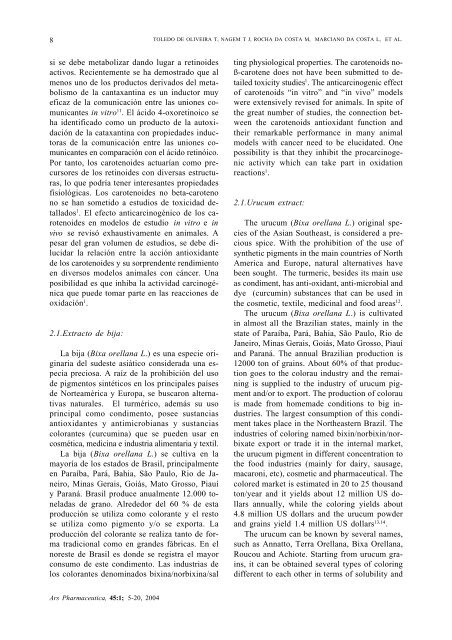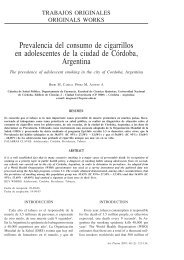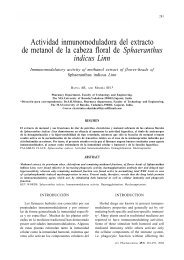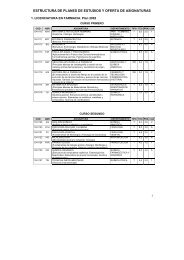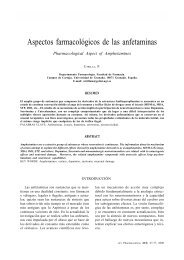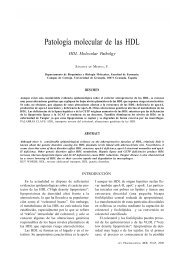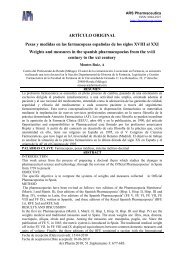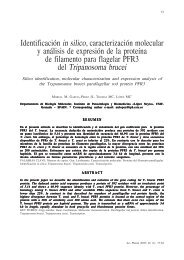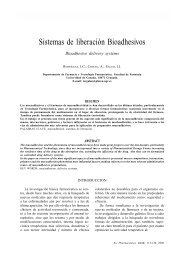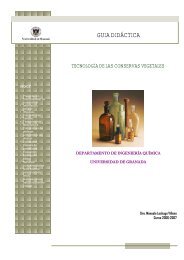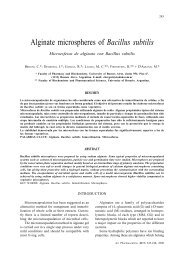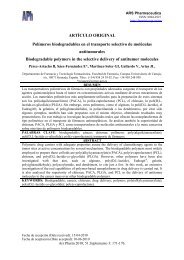Propiedades biológicas de los tintes naturales
Propiedades biológicas de los tintes naturales
Propiedades biológicas de los tintes naturales
You also want an ePaper? Increase the reach of your titles
YUMPU automatically turns print PDFs into web optimized ePapers that Google loves.
8<br />
si se <strong>de</strong>be metabolizar dando lugar a retinoi<strong>de</strong>s<br />
activos. Recientemente se ha <strong>de</strong>mostrado que al<br />
menos uno <strong>de</strong> <strong>los</strong> productos <strong>de</strong>rivados <strong>de</strong>l metabolismo<br />
<strong>de</strong> la cantaxantina es un inductor muy<br />
eficaz <strong>de</strong> la comunicación entre las uniones comunicantes<br />
in vitro 11 . El ácido 4-oxoretinoico se<br />
ha i<strong>de</strong>ntificado como un producto <strong>de</strong> la autoxidación<br />
<strong>de</strong> la cataxantina con propieda<strong>de</strong>s inductoras<br />
<strong>de</strong> la comunicación entre las uniones comunicantes<br />
en comparación con el ácido retinóico.<br />
Por tanto, <strong>los</strong> carotenoi<strong>de</strong>s actuarían como precursores<br />
<strong>de</strong> <strong>los</strong> retinoi<strong>de</strong>s con diversas estructuras,<br />
lo que podría tener interesantes propieda<strong>de</strong>s<br />
fisiológicas. Los carotenoi<strong>de</strong>s no beta-caroteno<br />
no se han sometido a estudios <strong>de</strong> toxicidad <strong>de</strong>tallados<br />
1 . El efecto anticarcinogénico <strong>de</strong> <strong>los</strong> carotenoi<strong>de</strong>s<br />
en mo<strong>de</strong><strong>los</strong> <strong>de</strong> estudio in vitro e in<br />
vivo se revisó exhaustivamente en animales. A<br />
pesar <strong>de</strong>l gran volumen <strong>de</strong> estudios, se <strong>de</strong>be dilucidar<br />
la relación entre la acción antioxidante<br />
<strong>de</strong> <strong>los</strong> carotenoi<strong>de</strong>s y su sorpren<strong>de</strong>nte rendimiento<br />
en diversos mo<strong>de</strong><strong>los</strong> animales con cáncer. Una<br />
posibilidad es que inhiba la actividad carcinogénica<br />
que pue<strong>de</strong> tomar parte en las reacciones <strong>de</strong><br />
oxidación 1 .<br />
2.1.Extracto <strong>de</strong> bija:<br />
La bija (Bixa orellana L.) es una especie originaria<br />
<strong>de</strong>l su<strong>de</strong>ste asiático consi<strong>de</strong>rada una especia<br />
preciosa. A raíz <strong>de</strong> la prohibición <strong>de</strong>l uso<br />
<strong>de</strong> pigmentos sintéticos en <strong>los</strong> principales países<br />
<strong>de</strong> Norteamérica y Europa, se buscaron alternativas<br />
<strong>naturales</strong>. El turmérico, a<strong>de</strong>más su uso<br />
principal como condimento, posee sustancias<br />
antioxidantes y antimicrobianas y sustancias<br />
colorantes (curcumina) que se pue<strong>de</strong>n usar en<br />
cosmética, medicina e industria alimentaria y textil.<br />
La bija (Bixa orellana L.) se cultiva en la<br />
mayoría <strong>de</strong> <strong>los</strong> estados <strong>de</strong> Brasil, principalmente<br />
en Paraíba, Pará, Bahia, São Paulo, Rio <strong>de</strong> Janeiro,<br />
Minas Gerais, Goiás, Mato Grosso, Piauí<br />
y Paraná. Brasil produce anualmente 12.000 toneladas<br />
<strong>de</strong> grano. Alre<strong>de</strong>dor <strong>de</strong>l 60 % <strong>de</strong> esta<br />
producción se utiliza como colorante y el resto<br />
se utiliza como pigmento y/o se exporta. La<br />
producción <strong>de</strong>l colorante se realiza tanto <strong>de</strong> forma<br />
tradicional como en gran<strong>de</strong>s fábricas. En el<br />
noreste <strong>de</strong> Brasil es don<strong>de</strong> se registra el mayor<br />
consumo <strong>de</strong> este condimento. Las industrias <strong>de</strong><br />
<strong>los</strong> colorantes <strong>de</strong>nominados bixina/norbixina/sal<br />
Ars Pharmaceutica, 45:1; 5-20, 2004<br />
TOLEDO DE OLIVEIRA T, NAGEM T J, ROCHA DA COSTA M, MARCIANO DA COSTA L, ET AL.<br />
ting physiological properties. The carotenoids noß-carotene<br />
does not have been submitted to <strong>de</strong>tailed<br />
toxicity studies 1 . The anticarcinogenic effect<br />
of carotenoids “in vitro” and “in vivo” mo<strong>de</strong>ls<br />
were extensively revised for animals. In spite of<br />
the great number of studies, the connection between<br />
the carotenoids antioxidant function and<br />
their remarkable performance in many animal<br />
mo<strong>de</strong>ls with cancer need to be elucidated. One<br />
possibility is that they inhibit the procarcinogenic<br />
activity which can take part in oxidation<br />
reactions 1 .<br />
2.1.Urucum extract:<br />
The urucum (Bixa orellana L.) original species<br />
of the Asian Southeast, is consi<strong>de</strong>red a precious<br />
spice. With the prohibition of the use of<br />
synthetic pigments in the main countries of North<br />
America and Europe, natural alternatives have<br />
been sought. The turmeric, besi<strong>de</strong>s its main use<br />
as condiment, has anti-oxidant, anti-microbial and<br />
dye (curcumin) substances that can be used in<br />
the cosmetic, textile, medicinal and food areas 12 .<br />
The urucum (Bixa orellana L.) is cultivated<br />
in almost all the Brazilian states, mainly in the<br />
state of Paraíba, Pará, Bahia, São Paulo, Rio <strong>de</strong><br />
Janeiro, Minas Gerais, Goiás, Mato Grosso, Piauí<br />
and Paraná. The annual Brazilian production is<br />
12000 ton of grains. About 60% of that production<br />
goes to the colorau industry and the remaining<br />
is supplied to the industry of urucum pigment<br />
and/or to export. The production of colorau<br />
is ma<strong>de</strong> from homema<strong>de</strong> conditions to big industries.<br />
The largest consumption of this condiment<br />
takes place in the Northeastern Brazil. The<br />
industries of coloring named bixin/norbixin/norbixate<br />
export or tra<strong>de</strong> it in the internal market,<br />
the urucum pigment in different concentration to<br />
the food industries (mainly for dairy, sausage,<br />
macaroni, etc), cosmetic and pharmaceutical. The<br />
colored market is estimated in 20 to 25 thousand<br />
ton/year and it yields about 12 million US dollars<br />
annually, while the coloring yields about<br />
4.8 million US dollars and the urucum pow<strong>de</strong>r<br />
and grains yield 1.4 million US dollars 13,14 .<br />
The urucum can be known by several names,<br />
such as Annatto, Terra Orellana, Bixa Orellana,<br />
Roucou and Achiote. Starting from urucum grains,<br />
it can be obtained several types of coloring<br />
different to each other in terms of solubility and


